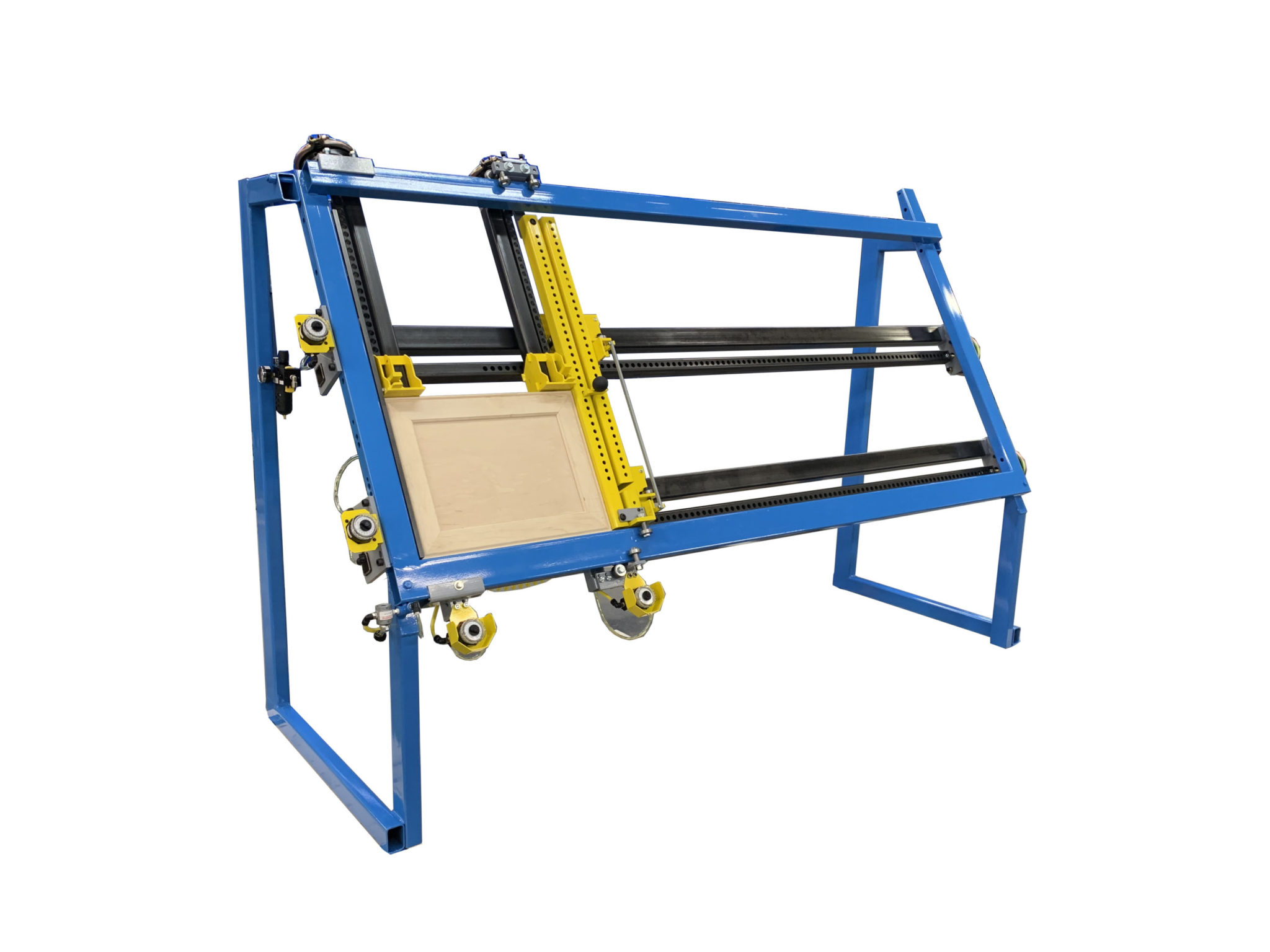Types of Mitered Cabinet Door Machines

The precise cut is paramount in cabinet making, and the heart of achieving that precision lies in the mitered cabinet door machine. These machines, ranging from simple hand-held tools to sophisticated CNC systems, offer diverse capabilities and cater to various production scales and budgets. Understanding their differences is key to selecting the right tool for the job. This exploration delves into the mechanics and capabilities of several prominent types.
Miter Saws
Miter saws, often the workhorse of smaller workshops and hobbyists, represent the most accessible entry point into precision mitering. These machines typically employ a spinning blade that descends vertically onto the workpiece, offering precise angled cuts. The operational principle hinges on a precisely calibrated rotating blade and a robust clamping mechanism to hold the wood securely during the cut. Smaller, portable miter saws are ideal for individual projects, while larger models with increased cutting capacity are suitable for small-scale production runs. Their simplicity and affordability are major advantages, but their speed and accuracy are generally lower than more advanced systems.
Sliding Compound Miter Saws
These saws improve upon the basic miter saw by adding a sliding mechanism, allowing for longer cuts and increased versatility. The sliding action enables the user to cut larger pieces of material without compromising the accuracy of the miter angle. The operational principle remains similar to a standard miter saw, but the added sliding feature significantly expands its capabilities. They offer a balance between affordability, accuracy, and cutting capacity, making them suitable for a wide range of applications, from individual projects to small-scale production. However, their speed is still limited compared to automated systems.
CNC Routers
CNC routers represent a significant step up in both capability and cost. These computer-controlled machines offer unparalleled precision and repeatability, capable of executing complex miter cuts with exceptional accuracy. The operational principle involves a computer program that directs the movement of a cutting bit, enabling intricate cuts and patterns. CNC routers excel in high-volume production environments where consistent quality and speed are critical. Their high initial investment is balanced by their ability to handle a wide range of materials and create intricate designs with speed and precision. However, the complexity of programming and operation requires specialized training.
Automated Miter Cutting Systems
These systems represent the pinnacle of mitered cabinet door production technology. They typically integrate multiple automated processes, including feeding, cutting, and sorting, to achieve maximum efficiency. The operational principle relies on a sophisticated interplay of automated mechanisms and sophisticated control systems, optimizing the entire production flow. These systems are designed for high-volume production, offering unparalleled speed, accuracy, and efficiency. While their initial investment is substantial, the return on investment can be significant for large-scale operations. However, their complexity necessitates specialized maintenance and skilled operators.
Comparison of Mitered Cabinet Door Machines
The following table summarizes the key characteristics of the different machine types:
| Machine Type | Speed | Accuracy | Material Compatibility | Price Range |
|---|---|---|---|---|
| Miter Saw | Low | Moderate | Wood, Plastics | $100 – $1000 |
| Sliding Compound Miter Saw | Moderate | High | Wood, Plastics, Some Metals | $500 – $3000 |
| CNC Router | High | Very High | Wood, Plastics, Metals, Composites | $5000 – $50,000+ |
| Automated Miter Cutting System | Very High | Very High | Wood, Plastics, Metals, Composites | $20,000 – $200,000+ |
Operational Flowchart for a Typical Miter Saw
The following flowchart Artikels the steps involved in operating a typical miter saw:
[Imagine a flowchart here. It would start with “Select Material,” branch to “Measure and Mark,” then “Secure Workpiece,” “Adjust Miter Angle,” “Initiate Cut,” “Inspect Cut,” and finally “Repeat as Needed.” Each step would be represented by a rectangle, with arrows indicating the flow of the process.] The process emphasizes the importance of safety precautions, including the use of appropriate personal protective equipment (PPE) such as safety glasses and hearing protection.
Mitered Cabinet Door Machine Maintenance and Troubleshooting

The precision and longevity of your mitered cabinet door machine are paramount to efficient production and high-quality results. Regular maintenance not only extends the lifespan of your equipment but also prevents costly downtime and ensures the consistent accuracy crucial for cabinet making. Proactive care minimizes the risk of unexpected failures and guarantees the smooth operation of this essential tool.
Mitered cabinet door machine – Understanding the common issues and implementing a preventative maintenance schedule is key to maximizing your return on investment and minimizing disruptions to your workflow. This section details best practices for maintaining your machine and provides practical solutions for resolving common problems.
Best Practices for Maintaining a Mitered Cabinet Door Machine
Implementing these best practices will significantly improve the performance and lifespan of your mitered cabinet door machine, reducing the frequency of repairs and ensuring consistently precise cuts. A well-maintained machine is a productive machine.
- Regular Cleaning: Remove sawdust and debris from all moving parts after each use. Compressed air is ideal for cleaning hard-to-reach areas. Wipe down the machine with a damp cloth to remove any lingering residue.
- Blade Maintenance: Sharpen or replace blades regularly according to the manufacturer’s recommendations. A dull blade will result in inaccurate cuts and increased wear on the machine. Inspect blades for chips or damage before each use.
- Lubrication: Lubricate all moving parts, such as bearings and guides, with the appropriate lubricant as specified in the machine’s manual. Proper lubrication reduces friction and extends the life of components.
- Tightening Fasteners: Periodically check all bolts and screws to ensure they are securely tightened. Loose fasteners can lead to misalignment and inaccurate cuts.
- Electrical Inspection: Regularly inspect power cords and connections for any signs of damage or wear. Replace any damaged components immediately. Ensure the machine is properly grounded.
Troubleshooting Common Problems
Addressing common problems promptly minimizes downtime and prevents minor issues from escalating into major repairs. The following steps offer practical solutions to some frequently encountered challenges.
- Problem: Inaccurate Cuts.
- Check blade sharpness and alignment. Replace or sharpen dull blades.
- Inspect and tighten all fasteners securing the blade and fence.
- Verify the fence is square to the blade. Use a square to check for alignment.
- Ensure the material is properly supported and clamped to prevent movement during cutting.
- If the problem persists, check the machine’s motor for any issues.
- Problem: Blade Binding or Jamming.
- Inspect the blade for debris or sawdust buildup. Clean thoroughly.
- Check the blade’s alignment to ensure it’s not rubbing against any part of the machine.
- Verify the material is not being fed too quickly or unevenly.
- Lubricate moving parts, paying special attention to the blade guides.
- Problem: Machine Not Powering On.
- Check the power cord and outlet for proper connection.
- Inspect the circuit breaker or fuse box for tripped breakers or blown fuses.
- If the problem continues, contact a qualified electrician.
Preventative Maintenance Schedule
A proactive maintenance schedule is essential for ensuring the longevity and peak performance of your mitered cabinet door machine. The following schedule provides a guideline for regular inspections and cleaning.
| Task | Frequency | Procedure | Notes |
|---|---|---|---|
| Clean machine (sawdust, debris) | After each use | Use compressed air and a damp cloth. | Pay attention to hard-to-reach areas. |
| Inspect blade for sharpness and damage | Before each use | Check for chips, nicks, or dullness. | Replace or sharpen as needed. |
| Lubricate moving parts | Weekly | Use manufacturer-recommended lubricant. | Focus on bearings, guides, and other moving components. |
| Check and tighten fasteners | Monthly | Inspect all bolts and screws. | Tighten any loose fasteners. |
| Inspect power cord and connections | Monthly | Check for damage or wear. | Replace damaged components immediately. |
| Thorough cleaning and inspection | Quarterly | Complete a detailed cleaning and inspection of all components. | Consider professional service if needed. |
Applications and Uses of Mitered Cabinet Door Machines in Cabinet Making
Mitered cabinet door machines represent a significant advancement in cabinetmaking, dramatically impacting both the efficiency and precision of the craft. Their ability to execute complex miter cuts with speed and accuracy allows for the creation of sophisticated cabinet designs previously unattainable through purely manual methods. This translates to faster production times, reduced material waste, and a higher overall quality of finish.
The precision afforded by these machines is paramount in achieving consistently perfect joints, crucial for the structural integrity and aesthetic appeal of any cabinet. This is particularly true when working with intricate designs or delicate materials.
Impact on Efficiency and Precision in Cabinet Production
The speed and accuracy of mitered cabinet door machines significantly enhance cabinet production. Manual cutting, even with the most skilled craftsman, is inherently slower and more prone to inconsistencies in angle and cut depth. A mitered cabinet door machine, however, can produce dozens of perfectly mitered cuts in the time it would take to hand-cut just a few. This increased throughput allows cabinetmakers to meet higher production demands and reduce labor costs. Furthermore, the machine’s precision minimizes material waste due to inaccurate cuts, saving both time and money. The resulting consistency in cut quality also leads to a superior final product with improved fit and finish.
Examples of Cabinet Styles and Designs
Mitered cabinet door machines find extensive application across a wide range of cabinet styles. Consider, for instance, the elegant simplicity of a Shaker-style cabinet. While seemingly straightforward, achieving the precise 45-degree miters on the frame and panel requires exceptional accuracy. A miter machine ensures perfect alignment, resulting in clean, flush joints that highlight the beauty of the wood grain.
More complex designs, such as those incorporating intricate crown moldings or angled framing, also benefit greatly from the capabilities of these machines. Imagine a modern kitchen cabinet with a beveled edge detail on the doors. The precise miter cuts needed for this design are easily accomplished with a miter machine, producing consistent results across multiple doors and drawers. Similarly, a custom-built entertainment center with multiple angled shelves and decorative trim pieces can be efficiently produced with the help of a miter machine, ensuring accurate angles and flawless joints. The consistent precision ensures a professional and high-quality finish.
Comparison of Mitered Cabinet Door Machines and Traditional Hand-Cutting Methods
Traditional hand-cutting methods, using hand saws or miter boxes, rely heavily on the skill and experience of the craftsman. While capable of producing high-quality results, this approach is inherently time-consuming and susceptible to human error. The precision of hand-cutting is also limited by the tools and the individual’s capabilities, leading to potential inconsistencies in the miter angles and the overall quality of the cut. This can result in gaps or misalignments in the finished cabinet.
In contrast, a miter cabinet door machine offers significantly improved speed and accuracy. The machine’s automated cutting mechanism ensures consistent miter angles and precise cut depths, regardless of the operator’s skill level. This leads to higher productivity, reduced material waste, and a more uniform final product. While the initial investment in a miter machine can be substantial, the long-term benefits in terms of efficiency and quality often outweigh the cost. The reduced labor costs and material waste contribute to a better return on investment over time. However, hand-cutting still retains its value for small-scale projects or specialized work where the machine might be impractical. The personal touch and the ability to adapt to unique challenges remain advantages of the traditional method.
